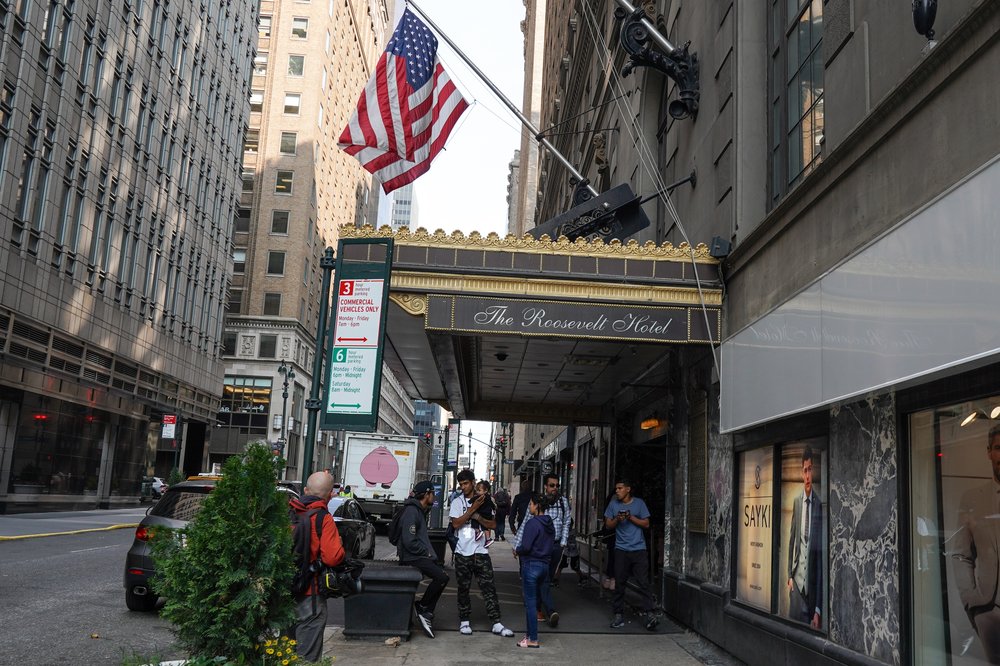Some NYC facilities housing migrants lack something basic: Showers
June 21, 2023, 6:10 p.m.
Councilmembers are pushing for minimum standards for facilities sheltering thousands of asylum-seekers.

A City Council oversight hearing on Wednesday on facilities housing asylum seekers grew visibly tense when an official in Mayor Eric Adams’ administration revealed that some sites lack even showers, requiring migrants to travel offsite for their bathing needs.
Councilmember Shahana Hanif, who helped lead the hearing along with Councilmember Diana Ayala and is also pushing legislation that would preserve access to city shelters for asylum-seekers, said she was stunned by the revelation.
“I understand the scale of how many people the city is serving,” she said during a heated exchange with Zachary Iscol, the head of NYC Emergency Management, which oversees the so-called respite centers.
“But for folks needing to step out of a facility to go to another facility [to shower], I do have to ask, how far is this park site? Or how far are people going, particularly if these are folks with families, to take a shower?”
With all due respect, I wish there was a piece of legislation that could be waved like a magic wand to magically create the capacity in the city for us to open up respite centers, shelters, HERCCs (Humanitarian Emergency Response and Relief Centers) or otherwise, with everything that is needed at that moment. That is not where we are today.
Zachary Iscol, the head of NYC Emergency Management
Her question brought a sarcastic response from Iscol.
“With all due respect, I wish there was a piece of legislation that could be waved like a magic wand to magically create the capacity in the city for us to open up respite centers, shelters, HERRCs [Humanitarian Emergency Response and Relief Centers] or otherwise, with everything that is needed at that moment,” said Iscol. “That is not where we are today.”
“The alternative is people sleeping on the streets,” he said. “That’s the alternative.”
Hanif and Iscol frequently spoke over each other during the exchange, which pointed up the growing chasm between councilmembers and Adams staffers regarding how to handle the migrant crisis. The divide has worsened since May, when the mayor suspended the city’s obligations under the decades-old right to shelter law, which he argued was a necessary response to the swelling population of asylum-seekers.
In the last year, some 74,000 asylum-seekers have flowed into New York City, with many of the migrants dispatched to the city by elected officials from border states.
In recent months, the Adams administration has sought to reduce the strain on the city’s shelter system by sending migrants to suburban communities, but that strategy has been partly undercut by court challenges. State Supreme Court Judge Sandra B. Sciortino on Wednesday granted Orange County a preliminary injunction, preventing Adams from sending additional migrants to Orange County “without complying with state social services law and a further order from the court."
Fabien Levy, a spokesperson for the mayor, replied that “we are in the midst of a humanitarian crisis.”
“Every day, we receive hundreds of additional asylum-seekers and we are out of space,” Levy said in a statement. “New York City has done and will continue to do its part, but we need counties, cities and towns across the state to do their part as well, especially when New York City is willing to pay for shelter, food and more.”
'That is not dignity'
At Wednesday’s City Council hearing, city Comptroller Brad Lander argued the right to shelter and its safeguards need to be brought back.
“New York’s right to shelter is a long-standing legal obligation that makes New York City a safer, more humane place for people without a home of their own,” said Lander. “We do not need to roll shelter safety protections back, and we should not.”
He noted that the city had opened 171 emergency sites since last year, including 11 HERRCs and that approximately 48,100 asylum-seekers are being housed by the city.
It is not clear how many of the facilities lack showers, and part of the standoff between the councilmembers and the Adams administration involves the growing number of city agencies that oversee facilities, making it harder for the council to exercise its oversight authority and to gauge at any one time the number of unsheltered people there are in the city.
Iscol pushed back against legislation introduced by Hanif that would require basic standards for asylum-seekers at the HERRCs, such as benchmarks for showers, toilets and sinks as well as meals and laundry facilities. Her legislation would also require at least 3 feet of space between cots, which Iscol argued was impractical.
“It’s performatory at best, I think it’s dangerous at worst,” said Iscol of Hanif’s legislation, insisting that his agency was committed to “the health and safety of those in our care.”
“We have to operate in the real world,” he said, “and this threatens to remove the flexibility we need to respond” to emergencies. He said it could also impact the willingness of organizations like the Red Cross to partner with the city in opening congregate facilities.
After the hearing, Hanif rejected Iscol’s reasoning.
“They said that they want flexibility, and that is simply not OK,” she said, given that some asylum-seekers lack showers.
“That is not dignity.”
How Mayor Adams was able to bypass NYC’s decades-old right-to-shelter rules Orange, Rockland barred from enforcing county orders targeting migrants Asylum seekers in Orange County settle in, meet allies and some foes